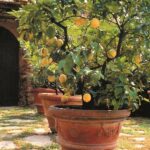Introduction
Container gardening is an excellent and efficient way to produce vegetables while using recycled containers as planters and saving time, money, and land. This type of gardening allows us to create a great variety of plants in both outdoor and indoor spaces, regardless of the size of the space. Containers such as bins, crates, buckets, even plastic bins are all suitable for use in container vegetable gardening, providing you with the opportunity to repurpose items that may have otherwise ended up in a landfill or been burned.
The benefits of container gardening are numerous; it requires little to no soil amendment as compared to traditional gardens, requires very little irrigation or nutrients from fertilizers and pesticides once set up properly, and takes far less time for maintenance than soil-based gardens. Container gardening can also act as an incredibly cost-effective way to garden since there is no need to buy large amounts of soil or expensive pots. Additionally, many vegetables like tomatoes do better in containers than traditional gardens due to their ability to be moved indoors in colder climates or avoid rot if grown too close together on the ground. Furthermore, portable containers make it easy for urban dwellers to take their garden with them when they move without having to re-soil an area when they arrive at their new home.
Choosing the Perfect Container
When it comes to recycled container gardening vegetables, choosing the right container is key. It is important to factor in the size of your veggies and how much room they need for rooting before selecting a pot. Most vegetables will do well in pots that are at least 10 inches deep and 14 inches across. If you plan to grow large vegetables such as pumpkins or watermelons, they will need larger containers or several separate ones. Consider using found or upcycled materials such as beach buckets, barrels, wagons, an old wheelbarrow, hanging buckets from a tree branch, or fabric grow bags for an interesting looking garden. Rain barrels are also great for reusing rainwater for your container garden plants. Be creative! Make sure whatever material you use has drainage holes since plants require well-drained soil so their roots don’t rot and die. Additionally, check the material used for toxics if it’s not food grade safe plastic like PVC free containers when growing edibles to ensure healthy eating pieces
Designing Your Garden
When designing your recycled container garden, there are a few pieces of equipment you will need. First, you’ll need a way to create some drainage in the containers. This can include a drill and/or plumber’s bit, mesh netting, and stones. Second, proper soil is essential for your garden to thrive; look out for soil specifically designed or amended for container gardens. Third, make sure you have the right tools to move and transport your containers since they may be heavy once filled with soil. Also keep in mind that many vegetables need at least 8 hours of sun during the day so take this into consideration when choosing your location and shape of your garden beds.
Your layout is also an important consideration for planning for your vegetable garden. You can either group crops together by their size or plant similar crops together in blocks or rows. Try mixing vegetables with companion plants such as legumes and herbs as these can increase yields and improve flavor. You can also practice crop rotation so that plants receive balanced nutrients from the soil; you should avoid planting the same crop in the same spot year after year if possible. Finally, consider using vertical supports like trellises or tuteurs to help provide a larger growing area without taking up more space on the ground.
Prepping the Soil for Planting
When it comes to improving your soil before planting a container garden of vegetables, proper preparation is essential. Organic matter and compost are the two most important ingredients for successful soil health, especially when recycling materials are used as containers.
Organic matter can come from a variety of sources, including leaves and plants that have died naturally or been harvested. It’s important to regularly incorporate fresh organic material into the soil to maintain fertility and create a home for beneficial microorganisms. Compost is also critical in improving nutrient content and drainage, as well as providing food for microorganisms. The best way to bring both organic matter and compost into garden containers is by mixing them with existing soil. The ratio of organic matter to soil can vary depending on the specific types of vegetables you’ll be growing in the container garden, so speak with an expert first if necessary.
You should also take time to evaluate the pH level of your vegetable garden container soil. For example, tomatoes thrive in neutral-pH soils, while carrots prefer more acidic environments. Make sure you consult guidelines regarding ideal pH levels for each type of vegetable you plan on growing before amending your soil with natural ingredients like lime or sulfur.
Finally, keep an eye out for potential weed problems in the garden container when you’re preparing the soil for planting vegetables. Make sure all weeds are removed during the process – best done by hand – since no amount of amendment will make up for poor drainage caused by clogged containers or waterlogged plots.
Plant Selection
Recycled container gardening vegetables are a great way to provide nutritious food and a variety of plants in your garden. When selecting vegetable varieties for planting, there are several strategies that you can use to maximize the return on your investment. First, be sure to choose high-quality seed, which can vary dramatically depending on the type of crop you’re growing. Look for disease-resistant varieties with good yields that will mature quickly and be suitable for the space you have available. When possible, select heirloom or organic varieties which offer flavors and textures not found in hybrid strains.
Second, consider forges ahead of planting time by combining plants that have similar life cycles such as salad greens, beans, corn and squash. This companion planting technique creates more efficient use of space and maximizes resources such as sunlight and water. Additionally, it makes harvesting much easier as it minimizes competition among plants for resources, light and space in the container garden. Furthermore, many vegetables benefit from being planted close together because they attract beneficial insects that act as pollinators or herbivore deterrents for their companion veggies. Be aware too that some vegetables are prone to cross pollination and should be isolated from other varieties in order to prevent contamination or unpredictable flavor/texture outcomes due to hybridization.
Finally, keep an eye out for diseases when selecting what vegetables to plant in your container garden as certain crops are more vulnerable than others to certain pathogens or insect infestations. Consider investing in baby cages or netting if needed in order to protect young seedlings from birds or small animals that could otherwise decimate entire crop beds with a single night’s meal! Successful economical vegetable gardening often relies on carefully considering each component of soil health prior to sowing seed or purchasing starter plants– choosing recycled materials helps ensure better quality soil while also reducing waste which is beneficial to both the environment and your pocketbook!
Watering & Fertilizing
Watering and fertilizing are essential for optimal health when growing vegetables in recycled containers. It is important to determine the ideal amount of water and fertilizer needed for a particular vegetable variety, as different types of vegetables have different water requirements. In general, containers should be watered when the top 1-2 inches (2.5-5 cm) of soil begins to dry out, and during especially hot or dry periods they may require more frequent watering. Planting a slow-release fertilizer at the base of plants can provide optimal nutrition throughout the growing season. Additionally, equipment such as soil moisture sensors and drip irrigation can help ensure that your recycled container garden is adequately hydrated with minimal effort. Finally, adding compost or other organic matter at least once a season will replenish nutrients in the garden’s soil and stimulate microbial activity which can help further nourish your vegetables organically while also improving drainage and aeration in densely-packed recycled containers.
Dealing with Pests & Diseases
Recycled container gardening is a great way to grow vegetables in a smaller, more manageable space. Unfortunately, many pests and diseases can threaten the health of your plants. To keep diseases and pests from ruining the success of your container garden, it’s important to take preventive measures and have plans for dealing with them when they do appear.
One way to minimize pest and disease problems is through careful planting selection. Choose plants resistant to certain disease-causing fungi, viruses, or bacteria common in your area by referring to the information provided on seed packets or plant tags. You should also buy only healthy plants from reputable nurseries as pre-existing infections can be transferred from one plant to another. Additionally, use organic potting mixes free of pathogens instead of garden soil as these areas provide good conditions for disease growth.
If pests or disease appear in your recycled container garden, there are a few treatment strategies that are simple yet effective. Begin by isolating affected plants away from unaffected ones so that you don’t transfer illnesses back and forth between them. Utilize biological control agents such as Bacillus thuringiensis to get rid of caterpillars or aphids that feed on vegetable foliage but won’t harm beneficial insects like bees and butterflies in the process. Handpicking insects off your plants can also help reduce pest populations. You can also use dormant oil sprays during winter months when temperatures are cold enough for pesticides not to persist in the environment yet still effective against certain insect species including mites, scale, and aphids . Finally, if necessary utilize low – toxicity products labeled for organic gardening like insecticidal soaps or horticultural oils specially developed for pest control.
Winterizing Your Garden
Winterizing your garden through recycled container gardening is a great way to ensure that your vegetables remain healthy during cold months. The most effective and sustainable way to accomplish this is by utilizing recycled containers such as buckets, pots, plastic crates or old bathtubs. These containers create an insulated environment for the roots of your vegetables, preventing the soil from freezing too deeply. Additionally, you can fill these containers with quality organic soil with added natural fertilizers like compost, compost tea or worm castings to maximize nutrient availability for your vegetables. Further insulation can be added by covering the containers with mulch or sawdust which helps to protect plants from extreme temperature fluctuations. A cold frame can also provide additional protection during the chilly winter months by enabling more sunlight penetration and trapping heat in the box. Finally, for optimal results make sure to select warm-weather vegetable varieties that are frost-resistant and suited for colder temperatures.
Roundup
Recycled container gardening vegetables is becoming an increasingly popular way to grow a variety of vegetables in a much smaller space than traditional garden methods. It has a large number of benefits and advantages that make it appealing to many different types of gardeners.
The most obvious advantage associated with recycled container gardening is the significant reduction in space needed. This allows people living in apartments or small yards to still have some way to grow their own food, no matter how limited the space they have available might be. In addition, this method doesn’t require any soil preparation and often very little soil altogether since containers can be filled with various other materials instead such as straw, compost, or weed-free mulch.
Environmental sustainability is another major benefit of recycled container gardening for those looking for eco-friendly options when creating edible gardens. Utilizing recycled materials such as old paint cans, gallon milk jugs and other items for containers for growing produce can significantly reduce waste, something that traditional gardening does not do well due to its reliance on plastic bags and wrapping elements.
Additionally, since containers require only minimal soil to retain moisture and nutrients, so less irrigation is necessary compared to larger gardens needing more water supply. Finally, recycling resources used in traditional gardens – like disposable plastics – are often reusable when it comes to container gardening (e.g., use the same bag of potting soil year after year). As a result, time spent sourcing materials like potting soil is drastically reduced when using recycled items.
In sum, the multiple benefits offered by recycled container gardening make it an attractive option for everyone from first-time gardeners looking to start small to experienced growers seeking more environmental-friendly alternatives that won’t take up too much space.
Conclusion
Recycled container gardening vegetables is an excellent way to liven up your living space and add delicious, nutrient-rich food to your diet. With just a little bit of planning and creativity, you can convert plastic containers into small home gardens in which you can successfully grow a variety of vegetables.
To get even more creative with your recycled garden, there are a few ideas you might consider. First, add compost or soil amendments to the container for added nutrients for the plants’ roots. Consider getting creative with the container shapes—different shapes allow for different planting arrangements as well as aesthetics. You can also transform plastic containers into window boxes or mount them on walls or fences. Other options include adding raised beds made from different materials such as wood, plastic, or steel. Lastly, consider adding additional features to enhance your recycled garden such as trellises for climbing plants, dividers to create pathways within the garden area, or faux walls to add privacy and interest. By taking advantage of these additional features and elements you can create beautiful areas where you can enjoy fresh food while admiring the beauty of your outdoor space.

Welcome to my gardening blog! I am passionate about plants and enjoy sharing my knowledge and experiences with others. In this blog, I will write about everything related to gardening, from tips on how to get started to updates on my own garden projects.





